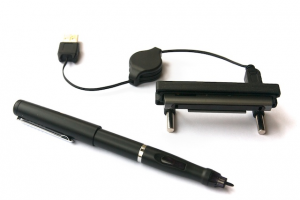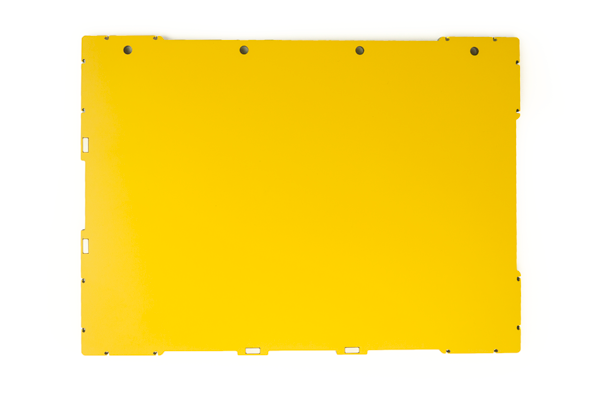The TactileView ClickPad holds both the tactile image, and the holder with the receiver for the TactileView digital pen.
The rubber bands on the corners of the ClickPad make sure the tactile image is always on the same position. The holder for the receiver is placed at the edges, using magnets in the sides. This results in the images always being in the correct position for pointing on them with the TactileView digital pen.
At a click of the pen, the horizontal and vertical distance to the upper left corner is measured and converted by the receiver. The exact position is then transmitted to the TactileView software on the computer. In the file, which matches the tactile image, these positions are used to play the corresponding audible information. When calibrated correctly, the position on which is clicked on the tactile image, always matches that same position in the digital equivalent.
Exchanging the tactile image is very easy, using the flexible paper clamps. Exploring diagrams in portrait can be alternated with diagrams in landscape by accordingly placing the receiver on either the long or the short side of the ClickPad.
tpmanualsection-en
01. Digital Pen – Introduction
Note: Since summer 2022, the Digital Pen has not been for sale anymore. This manual is for users who still own this former Thinkable product.
The TactileView digital pen is a special version of a ballpoint pen. The pen writes in ink like a normal pen, but at the same time determines the position of its tip on the drawing surface. In the pen’s tip is a small transmitter, which sends a signal to a receiver. Upon moving or clicking in the drawing surface with the pen, the receiver transmits this position to the TactileView software, just like with a regular computer mouse. Visual impaired people can operate the TactileView software using the TactiPad or TactileView ClickPad.
The pen functions as a drawing tool and transmits to the computer what has been drawn, or as a cursor by transmitting on which location has been clicked. This way, the digital pen enables the user to make a digital version of a tactile diagram or to explore a tactile diagram with speech and sound.

01. ClickPad – Audio-tactile images – Introduction
The TactileView ClickPad is a clipboard, on which a tactile image is placed. Combined with the TactileView digital pen and the TactileView software, the ClickPad functions as a touch screen. On this, a VIP (Visually Impaired Person) can explore an audio-tactile image; a tactile image that contains audible information as well. The digital pen is used as a click and point device similar to a computer mouse, and tells the computer on which position of the image has been clicked. The software then plays any audio information that is present at the clicked position.

14. CircleFrame – Repeating templates
By making different cardboard templates you can draw elegant repeating and overlapping patterns. This video shows how the small triangle can be used as a reference to make your own templates.
13. CircleFrame – Rubber bands
When the notches around the outside of the CircleFrame are combined with rubber bands, you can a grid of radial lines as guidelines for your drawings, as can be seen in this video.
12. CircleFrame – Drawing patterns
The largest of the three drawing tools that come with the CircleFrame consists of a triangle with different templates on all sides. This video shows how this tool can be combined with the CircleFrame to create interesting overlapping patterns.
11. CircleFrame – Combining with the compasses
This video shows the different ways in which the compasses can be used to make beautiful circular patterns or concentric circles within the CircleFrame.
10. CircleFrame – Drawing a clock
Using the slots in the wedge-shaped tool you can easily draw the hands of a clock, as explained in this video.
09. CircleFrame – Creating pie charts
This next video shows how the clearly defined tactile degrees indicators along the inner edge of the circle in the CircleFrame can be combined with the wedge-shaped tool to create accurate pie charts.
08. CircleFrame – Introduction
This first video shows the different features that make up the CircleFrame, the drawing tools that are supplied with the CircleFrame, how it can be positioned on the TactiPad and how to use the different indicators as a basis for your drawings.
